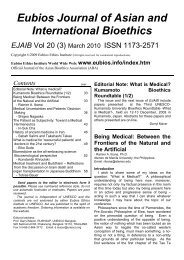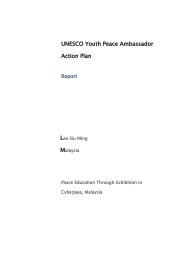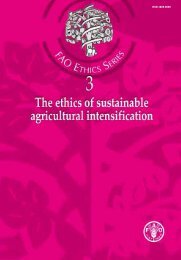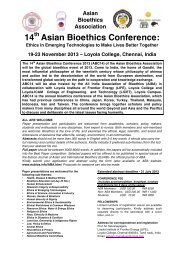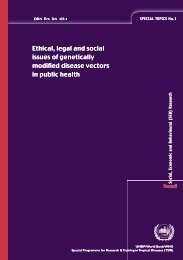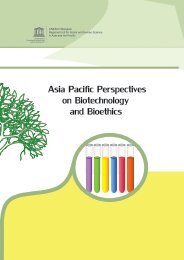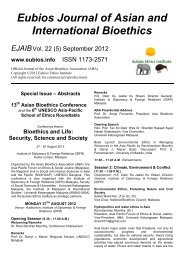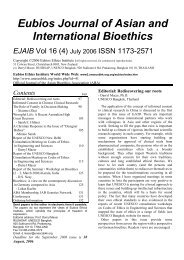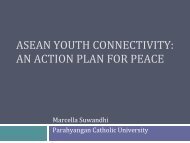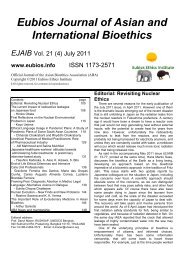Eubios Journal of Asian and International Bioethics EJAIB
Eubios Journal of Asian and International Bioethics EJAIB
Eubios Journal of Asian and International Bioethics EJAIB
- No tags were found...
Create successful ePaper yourself
Turn your PDF publications into a flip-book with our unique Google optimized e-Paper software.
28<strong>Eubios</strong> <strong>Journal</strong> <strong>of</strong> <strong>Asian</strong> <strong>and</strong> <strong>International</strong> <strong>Bioethics</strong> 18 (January 2008)gender, education etc., <strong>and</strong> subsequently influences variousstages <strong>of</strong> the decision-making process.Forsyth projects that an individual's personal moralphilosophy is composed <strong>of</strong> both relativism <strong>and</strong> idealism,which are self-governing magnitudes. Relativism is thedimension to which the individual discards universal moralsystem <strong>and</strong> founds her own moral judgment on the state <strong>of</strong>affairs per se, along with this states, as well as the peopleconcerned, more than on ethical principles. Idealism is theextent to which the individual focuses moral judgment onvalues pertaining to the principle <strong>of</strong> nonmalificence(Beauchamp 2001, <strong>and</strong> Tang 2003). The suppositions areharmonious with previous non-bioethical study that individualswith lower levels <strong>of</strong> relativism perceive higher levels <strong>of</strong> moralintensity than those with higher levels <strong>of</strong> relativism(Beauchamp 2001, <strong>and</strong> Tang 2003, Singhapakdi 1999,Arrington, <strong>and</strong> Douglas).Of significance in this background is the fact that idealismis not equal to moral absolutism, but rather a conviction invalues such as unselfishness <strong>and</strong> a meaning <strong>of</strong> hopefulness.Idealism <strong>and</strong> relativism have thus far revealed explicatorystrength related to ethical judgment <strong>and</strong> decisions in business(Arrington). As well, idealism <strong>and</strong> relativism are significantlyrelated to moral intensity (Douglas). Idealism is inclined tointensify discernments <strong>of</strong> moral intensity, whilst relativismtends to decrease them (See the Model in Figure 1).Arguments <strong>and</strong> Counter Arguments <strong>of</strong> this ProposedModel, With a Lively Examples, on Which this ProposedModel Could Have Been Applied During the Decision-Making ProcessThat being stated, lively examples are to be illustrated <strong>and</strong>discussed as follows. Scientists have used fetal tissue inresearch since at least the 1930s. Ge<strong>of</strong>frey Chamberlainreceived a pr<strong>of</strong>essional award for research (outlined in theMarch 1968 issue <strong>of</strong> The American <strong>Journal</strong> <strong>of</strong> Obstetrics <strong>and</strong>Gynecology), in which he took live aborted fetuses, attachedthem to an artificial placenta, perfused the fetuses with theblood from the latter, in order to see if he could make thefetus continue to be alive or not, <strong>and</strong> then he pulled the plug<strong>of</strong>f on the fetus. No one objected to him at that time. Judge noone; yet, the following discussion from the approach <strong>of</strong> thisproposed model merits attention. The more theaforementioned six components <strong>of</strong> moral intensity that arepresent, the more likely it is that an individual will recognizethe existence <strong>of</strong> an ethical problem, with a subsequent effecton judgment, intentions, <strong>and</strong> behavior. Once more, judge noone, had moral intensity been positively impacted withstronger personal moral philosophy along with other relatedfactors, as well as had this proposed model been applied, theconclusion <strong>of</strong> the event by Chamberlain would have beencompletely different at that time. It appears that there wouldhave had lots <strong>of</strong> objection to Chamberlain's act at that time.Hence, in accord with what have been previously pointed out,moral issues can be considered with regard to fundamentaldistinctiveness that affects the different phases <strong>of</strong> the decisionmaking process. Furthermore, it is as well noteworthy thatmoral intensity is inherent in any ethically uncertain situation(Wood).Another instance is as follows. Nowadays, the secrets <strong>of</strong>the 'Dead-Baby Industry' reveal that aborted fetuses beingdissected alive, harvested <strong>and</strong> sold in pieces to increase avast research enterprise (Canadian, Likoudis). Theinterchange in fetal tissue springs worldwide into esteemedtax-funded laboratories. The research per se is usually forcreditable objectives, from helping prenatal infants survive tocuring Parkinson's disease (Moriera). But the trade, worthbillions, brings up innumerable moral <strong>and</strong> ethical problems:Are some humans’ embryos <strong>and</strong> fetuses being killed tobenefit others? Are women being exploited to support thecollection <strong>of</strong> fetal tissue? Who is pr<strong>of</strong>iting from the trade? Inaddition, what are the social insinuations <strong>of</strong> such anexistence?Those questions deserve proper answers upon all <strong>of</strong> ourreflection based on positively charged moral intensity asindicated in this proposed model. Obviously, as clearlyindicated in the section <strong>of</strong> Arguments (vide infra: inside thesection <strong>of</strong> Discussion), if the fetus was already aborted beforethe issue <strong>of</strong> tissue transplant even took place, there is nosense in which the fetus' life is being traded for another.Nevertheless, with such a huge monetary amount <strong>of</strong> tradinggoing on, for argument sake, even if the fetus were alreadyaborted before the transplantation occurred, how couldanyone guarantee that such a desire for abortion has neverbeen motivated financially?Conversely, <strong>of</strong> significance in this context is the fact thatsome adult pr<strong>of</strong>essional even sarcastically states indocumented evidence that ‘although life is sacred <strong>and</strong> a fetusis alive, he still can support research to certain degrees.’ Sucha kind <strong>of</strong> slippery argument is hardly justified. Clearly, thefetus cannot make any decision by himself; besides, he is notviable in so doing at all. Even if he were so much willingly <strong>and</strong>volitionally to contribute or support research to merely a‘certain’ degree, eventually, it has to be at the expense <strong>of</strong> his(the fetus’) own life, but no one else’s. Obviously, researcherswho ever made such kind <strong>of</strong> statement require thereinforcement <strong>of</strong> moral intensity, <strong>and</strong> better be guided withthis proposed model. For the purpose <strong>of</strong> completeness, thelast counterargument against the aforementioned issue is asfollows. Although life is sacred <strong>and</strong> a fetus is alive, if he canreally support research to certain degrees, likewise, he can aswell decide not to support such a research. Why cannot he?Of importance in this context <strong>of</strong> aforementionedarguments lies in the fact that when he (the fetus) supportsfetal tissue transplantation <strong>and</strong> embryonic <strong>and</strong>/or fetal stemcell research to certain degree as on the very same premisebeen based, there will at least two issues as follow. First, ishe volitionally for so doing? Second, there is a very much highlikelihood that he will lose his own life, <strong>and</strong> will be no longeralive when he 'supports' such a research, notwithst<strong>and</strong>ing,lack <strong>of</strong> informed consent given by himself. If there were somekind <strong>of</strong> informed consent given for so doing, then not only isthe degree <strong>of</strong> transparency <strong>of</strong> that so called ‘consent’ isdubious, but also the motivation for so doing is in question.After all, the consent, if any, is definitely not given by him! Thelast but not least, if he can consent himself for such a decisionto support stem cell research, so can he consent the oppositedecision not to support. Such kind <strong>of</strong> argument in fact reallyviolates the principles <strong>of</strong> non-maleficence <strong>and</strong> justice.The aforementioned examples, arguments, <strong>and</strong> counterarguments well illustrate the fact that this proposed modelwith moral intensity, along with the principles <strong>of</strong> beingtransparent <strong>and</strong> that <strong>of</strong> respect to the human biologicaltissues, can help the process <strong>of</strong> bioethical decision-making.Hence, moral intensity indeed is predicated on anindividual's evaluation <strong>of</strong> six different components aspreviously stated (vide infra: the section <strong>of</strong> the concept <strong>of</strong>Moral Intensity) (Jones), which are pertinent to a given ethicalsituation. An appraisal <strong>of</strong> the components guides us to reachthe impression that adequately evaluating factors involved ism<strong>and</strong>atory. Such factors include but not limiting in personalmoral philosophy, along with other related elements with theirrespective magnitude <strong>and</strong> likelihood <strong>of</strong> possibleconsequences, the timeframe <strong>and</strong> concentration <strong>of</strong> suchconsequences, <strong>and</strong> the relationship among the evaluatingindividuals or so called rater <strong>and</strong> those who might beinfluenced by the action or inaction.The Other Factors Involved in this Proposed ModelThe balance <strong>of</strong> factors, such as that <strong>of</strong> education,occupation, gender, <strong>and</strong> age on the individual’s perception <strong>of</strong>ethically questioned issues also need to be considered. They



